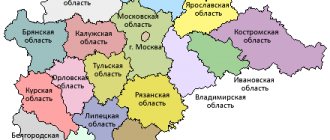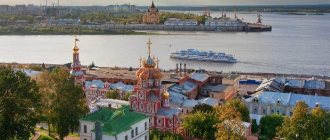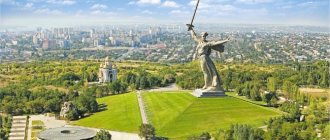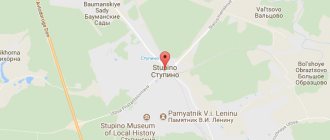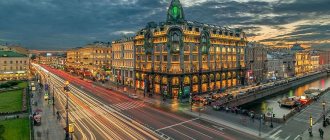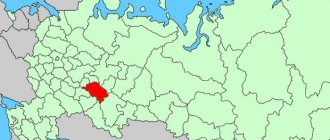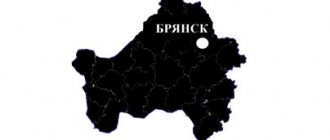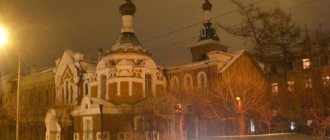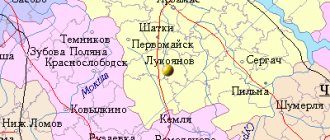The center of the Siberian Federal District is Novosibirsk. What other region of Russia can compare with it in terms of the size of the territory included in it? It is second only to the Far Eastern District. It consists of regions, territories and republics. The total number of subjects is 12, the territory makes up a third of Russia. Its borders extend both by land and by sea.
How many federal districts are there in Russia?
In total, there are 8 federal districts in Russia: Central, Volga, Siberian, Southern, Northwestern, Ural, North Caucasian and Far Eastern.
Interesting materials:
How to fix error 0xe06d7363 when starting the game? How to change the name in Google Play games? How to change the resolution of the game Far Edge 4? How to change the resolution in the game Mafia 1? How can I transfer the game to a flash drive? How can I sell a game on Steam? How can I close the game stalker? How to start the Harry Potter game again? How to start a game on PSP? How to start the game again Wonderful Garden?
Founding of Novosibirsk
Novosibirsk is a city with a population of one million in Russia. It ranks third in terms of population (1,602.9 thousand people). The largest city in Siberia, the center of the region, the federal district of Russia is Novosibirsk. What significance does it play in the history of the country? First of all, it is the largest industrial, scientific and cultural center, which has a huge impact on the development of the region and the country.
Until 1925, the city was called Novo-Nikolaevsk; it was built on the site of the village of Krivoshchekovskie settlements, located on the right bank of the Ob River. Before this, the village of Krivoshchekovo was located on the left bank, but the Great Siberian Road, which later became known as the Trans-Siberian Railway, was laid across its territory.
(adsbygoogle = window.adsbygoogle || []).push({});
It was with the construction of the railway that the history of the formation of Novosibirsk, which is part of the Siberian Federal District, began. But this is today, and in those days it could have remained a railway station, like many others along the entire length of the road. But, as always, chance intervened.
Healthcare
According to data for 2012, in the Siberian Federal District there are 197.6 thousand hospital beds, which is 102.6 beds per ten thousand residents (in the Russian Federation - 94.2 units); doctors of all specialties - 102.2 thousand people, based on ten thousand inhabitants - 53.1 doctors (in the Russian Federation - 51.2 specialists); paramedical personnel - 222.1 thousand people, based on ten thousand inhabitants - 115.3 people (in the Russian Federation - 107 people).
Siberian Federal District
Date of formation: May 13, 2000. The Siberian Federal District includes 12 subjects of the Russian Federation (since January 1, 2007, the Taimyr (Dolgano-Nenets) Autonomous Okrug and the Evenki Autonomous Okrug are part of the united Krasnoyarsk Territory. Since January 1, 2008, the Ust-Ordynsky Buryat Autonomous Okrug is part of the united Irkutsk Region. On March 1, 2008, as a result of the merger of the Chita region and the Aginsky Buryat Autonomous Okrug, the Trans-Baikal Territory was formed).
The territory of the Siberian Federal District makes up 30% of the territory of Russia, the population is 20.06 million people. The following are concentrated in Siberia: 85% of all-Russian reserves of lead and platinum, 80% of coal and molybdenum, 71% of nickel, 69% of copper, 44% of silver, 40% of gold. The gross regional product is 11.4% of Russia's GDP. The district's share in the total industrial production of the Russian Federation in 2001 was 12.4%. The share of the Siberian Federal District in the total length of Russian railways is 17.5%.
general characteristics
Date of formation : May 13, 2000.
Composition of the Siberian Federal District
12 constituent entities of the Russian Federation, including:
- 4 republics (Altai, Buryatia, Tyva, Khakassia);
- 3 regions (Altai, Transbaikal, Krasnoyarsk);
- 5 regions (Irkutsk, Kemerovo, Novosibirsk, Omsk, Tomsk).
Administrative center - Novosibirsk
Administrative division
A total of 4190 municipalities, of which:
- municipal districts - 320,
- urban districts - 79,
- urban settlements - 261,
- rural settlements - 3530.
Territory
total area
- 5114.8 thousand km2 (30% of the territory of Russia).
Length of territory
- north to south – 3566 km;
- from west to east – 3420 km.
The county borders
- in the north - with the Yamalo-Nenets Autonomous Okrug, which is part of the Tyumen region;
- in the west - with the Tyumen region, the Yamalo-Nenets Autonomous Okrug, the Khanty-Mansiysk Autonomous Okrug;
- in the east - with the Republic of Sakha (Yakutia), Amur region;
- in the south - with the Republic of Kazakhstan, the Republic of Mongolia, and the People's Republic of China.
Length of the state border
- 7269.6 km,
including:
- with the Republic of Kazakhstan - 2697.9 km;
- with the Republic of Mongolia - 3316.2 km;
- with the People's Republic of China - 1255.5 km.
Characteristics of the state border
- border outposts – 120;
- border checkpoints – 63;
- customs posts – 71.
Population
(Here and below are the data from the 2002 All-Russian Population Census)
Population – 20,062.9 thousand people.
Population density – 3.9 people. per 1 km2.
The share of the urban population is 71.1%, rural – 28.9%.
National composition
- Russians - 87.38%
- Buryats - 2.13%
- Ukrainians - 1.86%
- Germans - 1.54%
- Tatars - 1.26%
- Tuvans - 1.20%
- Kazakhs - 0.62%
- Belarusians - 0.41%
- Khakass - 0.36%
- Altaians - 0.33%
- Chuvash - 0.31%
- Azerbaijanis - 0.30%
- Armenians - 0.30%
Natural resources
Mineral resources
The following are concentrated in Siberia:
- 85% of all-Russian reserves of lead and platinum;
- 80% coal and molybdenum;
- 71% nickel;
- 69% copper;
- 44% silver;
- 40% gold.
Land resources:
- 59.0% of land under forests;
- 8.1% - swamps;
- 11.1% - agricultural land;
- 3.3% - water bodies;
- 18.5% - other lands.
Of all the lands under reindeer pastures – 11.0%.
Forest resources
The total area of the forest fund is 371,899 thousand hectares;
- including the area occupied by coniferous species - 190,268 thousand hectares.
The total standing timber stock is 33,346 million m3.
Specially protected natural sites
On the territory of the district there are:
- 21 state nature reserves (42.3% of the area of Russian reserves);
- 6 national parks (35.9% of the area of Russian national parks).
Hunting grounds
The area of the district's hunting grounds is 30.7% of the total area of hunting grounds in Russia.
Economy
The leading sector of the economy of the Siberian Federal District is industry.
Gross regional product – 715.2 billion rubles. (or 11.4% of GRP in Russia).
Gross regional product per capita – 34.5 thousand rubles. (in Russia – 43.3 thousand rubles).
Industry
The district's share in the total industrial production of the Russian Federation in 2001 was 12.4%.
Leading industries:
- non-ferrous metallurgy;
- electric power industry;
- forestry and woodworking;
- ferrous metallurgy;
- chemical and petrochemical;
- food and flour milling;
- fuel;
- building materials;
- mechanical engineering and metalworking;
- light.
Agriculture
The district's share in the total volume of agricultural production in Russia in 2001 was 16.2%.
The most important branches of agriculture: livestock breeding, grain production, vegetable growing.
The volume of agricultural production in 2001 was 161,875 million rubles, including products:
- crop production – 83933 million rubles;
- livestock farming – 77942 million rubles.
Foreign trade activities
Foreign trade turnover in 2006: (according to customs statistics)
- 36984.5 million US dollars (including the volume of exports - 31949 million dollars; imports - 5035.5 million dollars).
The Siberian Federal District is the main transport hub of Russia
The unique geopolitical position of Siberia (together with the Far East) as a bridge between Europe and Asia.
The main transit flows of Russia (freight and passenger transportation) from the European part of the country to the Asian part pass through the Siberian Federal District.
Share of the Siberian Federal District in the total length:
- Russian railways – 17.5% (2nd place);
- highways (general and departmental use) in Russia – 16.8% (3rd place);
- navigable inland waterways of Russia – 29.7% (1st place).
The territory is attractive for international cooperation
On the territory of the district there are representative offices of 7 foreign countries:
- Federal Republic of Germany (Novosibirsk - Consulate General of the Federal Republic of Germany);
- Mongolia (Irkutsk, Kyzyl (Republic of Tyva), Ulan-Ude (Republic of Buryatia) - Consulates General of Mongolia);
- Poland (Irkutsk - Consulate General of Poland);
- Israel (Novosibirsk - Israeli Cultural and Information Center);
- Italy (Novosibirsk - department of the department for the development of trade exchanges of the Italian Embassy);
- Republic of Belarus (Novosibirsk - branch of the Embassy of the Republic of Belarus);
- Bulgaria (Novosibirsk - Consulate General of Bulgaria).
The Siberian Federal District includes territories with extreme living conditions
to the regions of the Far North and equivalent areas:
Republic of Tyva, Taimyr (Dolgano-Nenets) municipal district, Evenki municipal district; partly the territory of 6 subjects - the Republic of Buryatia, the Altai Republic, the Krasnoyarsk Territory, the Trans-Baikal Territory, the Irkutsk, Tomsk regions. About 70 thousand people live in the district. 18 nationalities of indigenous peoples of the North and Siberia (more than one third of the 45 indigenous peoples of the North and Siberia living in the Russian Federation).
Social complex
The science
On the territory of the district there are Siberian branches of 3 Russian Academies of Sciences - SB RAS (Siberian Branch of the Russian Academy of Sciences), SB RAAS (Siberian Branch of the Russian Academy of Agricultural Sciences), SB RAMS (Siberian Branch of the Russian Academy of Medical Sciences), which includes more than 100 research organizations, as well as a network of research and experimental stations.
Education
- The number of daytime educational institutions is 11,168 (including 77 non-state ones);
- The number of state secondary specialized educational institutions is 401;
- The number of higher educational institutions is 110 (including 28 non-state ones).
The largest number of universities is concentrated in the Novosibirsk (24), Omsk (18) regions, Krasnoyarsk Territory (15), Irkutsk (14), Kemerovo (10) and Tomsk (8) regions. The total number of students in various types of educational institutions in the district is 4045.0 thousand people. (14.8% of the total number of students in Russia),
including:
- in daytime educational institutions - 2919.9 thousand people. (15.0% of students in Russian schools);
- in secondary specialized educational institutions - 369.8 thousand people. (15.3% of the number of Russian secondary school students);
- in universities - 755.3 thousand people. (13.9% of the number of Russian university students).
Healthcare
Number:
- hospital institutions – 1847;
- hospital beds - 234.6 thousand units;
- medical outpatient clinics - 3644 with a capacity of 507.6 thousand visits per shift;
- doctors of all specialties - 96.3 thousand people;
- nursing staff - 218.1 thousand people.
In terms of the number of doctors per 10 thousand population (46.5), the district ranks 4th, and the number of nursing staff per 10 thousand population (105.5) is 6th in Russia.
Culture
- the number of theater spectators per 1000 population is 205 (3rd place in Russia);
- number of museum visits per 1000 population – 342 (3rd place in Russia);
- library collection of public libraries per 1000 population, copies – 6465 (5th place in Russia);
- newspaper production per 1000 population (single circulation, copies) – 283 (7th place in Russia).
Physical education and sports
Number of sports facilities – 23557;
including:
- stadiums with stands for 1,500 or more seats – 375 (3rd place in Russia);
- flat sports structures (grounds and fields) – 14469 (4th place in Russia);
- gyms – 8323 (3rd place in Russia);
- swimming pools – 390 (3rd place in Russia).
City development
In 1926, the city was renamed and received its modern name Novosibirsk. It developed rapidly, which allowed A. Lunacharsky, who visited it in the late 20s, to call it “Russian Chicago.” During the Second World War it became a large industrial city. In addition to their enterprises, such as the aviation industry, enterprises from the central part of the USSR were evacuated here.
In 1937, the Altai Territory, Novokuznetsk and Tomsk regions were removed from the West Siberian Territory. Since 1943, the Novosibirsk region was formed with the regional center of Novosibirsk. In 1957, the Siberian Branch of the USSR Academy of Sciences was created. Academy Town was built on the outskirts of the city. The city becomes the largest scientific center not only in Siberia, but also in the country.
(adsbygoogle = window.adsbygoogle || []).push({});
Geography and climate of Kemerovo
So, the city itself is almost 3 thousand kilometers in a straight line from the capital. On roads this distance increases to 3601 km. The two parts of the city are located on the banks of the Tom River and are connected by two road and one railway bridges.
The time here is Krasnoyarsk and relative to Moscow it is offset by 4 hours. Since 2014, a sixth time zone has been established in the region, which has increased the time difference with the capital to four hours.
There is a sharply continental climate and very cold winters, which, by the way, are also 2.5 months longer than the calendar frosts. Temperatures are below zero already at the end of October, and winter ends only in April. At the same time, summer is warm and humid, although it is 11 days shorter than the calendar year. In 2014, abnormal precipitation was recorded in early June, when wet snow fell throughout the territory.
Recent statistics have shown a decrease in atmospheric emissions from enterprises, which is good news. Of course, we cannot discount the growing number of cars in the city, which somewhat changes the main source of environmental pollution.
Infrastructure of Kemerovo
Is it worth moving to the city for permanent residence? The question is ambiguous, but it is worth noting that living here is comfortable. The problems of bad roads are gradually being solved, and highways within the city can boast of almost exemplary smoothness. But the roads are narrow, and there is a lot of traffic, so transport hubs are overloaded. That’s why the courtyards are always filled with cars, especially Lenin Avenue and Tereshkova Street. In addition, a federal highway with a flow of trucks passes through the city. But the city is far from overcrowded and this seriously smoothes out the situation. In 2014, the wide Kuznetsky Bridge was built.
The city has public transport, namely trams, trolleybuses, taxi and bus routes. The fare is steadily rising. You can get out of the city by rail, highways or by road. Buses run throughout the region and even to neighboring countries. The city's airport is a hub for international transportation, but it will be cheaper to book tickets from Novosibirsk.
Housing and communal services issues are the most important for the entire country, and in Kemerovo the situation is not significantly different from other cities. Almost all citizens install separate meters.
Even in the last century, the city was almost entirely made up of wooden houses, barracks on one floor. High-rise buildings began to be built only in the sixties, and the Central District was the first to be built. By the way, development is actively underway now, so there are no problems with real estate. The size of the city is very non-standard and the ratio of multi-storey and private houses is approximately equal. In general, the picture is quite pleasant, since the city has a developed center.
The city's social policy is very active, queues for kindergartens drag on for years, but there are no problems with enrollment in schools. In addition, innovative projects are being implemented across the region on scientific platforms; You can choose schools for your child according to his abilities and wishes. Further, parents have a choice of 7 state universities, 5 branches and 2 non-state educational institutions.
From Siberia to Altai
In May 1893, builders of a settlement of bridge workers arrived on the right bank, which would be built north of the village of Krivoshchekovskie settlements. After a while they will merge together and receive the single name Novo-Nikolaevsk. In ten years, the village at the Ob railway station will be awarded the title of a city without a district.
In St. Petersburg, a decision is made to connect Siberia with Altai by rail. Thanks to the efforts of the city mayor of Novo-Nikolaevsk V. Zhernakov, a decision was made to build a railway branch to the city of Semipalatinsk through Novo-Nikolaevsk in 1912. This played a major role in the development of the future of Novosibirsk, the center of the Siberian Federal District. The history of the city has changed dramatically; it is becoming a transnational transport hub.
Enterprises and work in Kemerovo
Perhaps city guests will be interested in employment opportunities. So, much more people in physical labor are needed here than humanities specialists.
You can find vacancies at industrial plants, work in the chemical and energy fields, and engage in machine construction and woodworking. In addition, Kemerovo is a concentration point for large enterprises. Most often, people seek to get a job at SDS-Holding, which covers almost all business areas from alcohol to engineering.
KPO Azot, which deals with chemical products and the production of agricultural fertilizers, is quite attractive for employment. There are almost always vacancies here. Specialists of a narrow profile are required at the LLC Production Association Khimprom, which is famous for the production of auto chemical goods for cars. Specialists are rarely required at Tokem LLC. Now it is the largest manufacturer of polymer materials.
Orton OJSC, which produces geosynthetic materials, is not particularly popular. Perhaps the low rating is due to low salaries and hard work. Mostly local residents work here, but migrants bypass society.
Kemerovo, by the way, is considered the scientific and educational center of the region, which is confirmed by the development of service and trade sectors. There are a lot of shopping centers in the city, so you can find not only work, but also entertainment. Visitors will find the Promenade shopping mall and the Greenwich shopping mall, but the Semyorka shopping mall is considered more modest. Well, it’s worth visiting the TSUM shopping center, which is common to all cities of the country.
Administrative center of the Siberian Territory
In 1920, the Bolsheviks, remembering the dominant role of Tomsk in the white movement, moved the administrative center to Novo-Nikolaevsk. But the uprising in the South-West of the Tomsk province, the siege of Novo-Nikolaevsk, its harsh suppression, and the evacuation of all administrative and party institutions to Tomsk forced the Soviet government to temporarily abandon this step.
After the civil war, the entire country lay in ruins. The inhabitants of Novo-Nikolaevsk were just over 20 thousand people. The railway did not work. The most important task was to restore the functionality of the huge transport hub. Therefore, the Bolshevik government decides to establish the Novo-Nikolaevsk province on part of the territories of the Omsk and Tomsk provinces.
On May 25, 1925, the administrative unit of the Siberian Territory was formed, headed by the city of Novo-Nikolaevsk. This became the prototype of the status of modern Novosibirsk - the federal district, which it has had since 2000. It included the provinces: Novo-Nikolayevskaya, Tomskaya, Altaiskaya, Omskaya, Yeniseiskaya, in addition, the autonomous region - Oirotskaya, which was later included in the Altai Territory.
